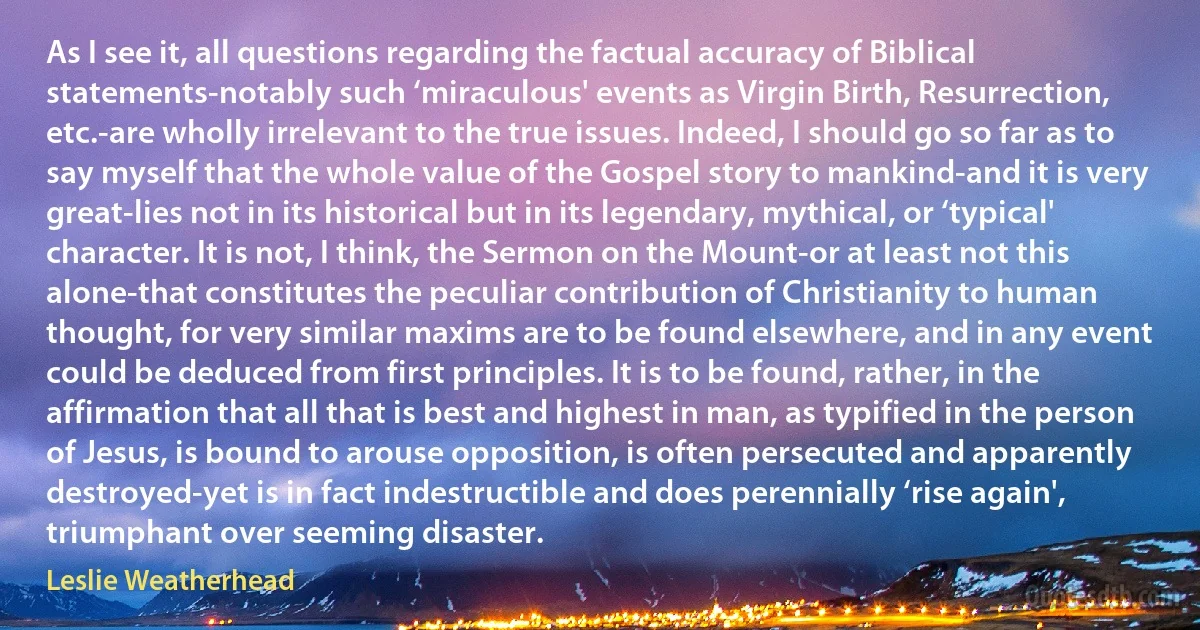
As I see it, all questions regarding the factual accuracy of Biblical statements-notably such ‘miraculous' events as Virgin Birth, Resurrection, etc.-are wholly irrelevant to the true issues. Indeed, I should go so far as to say myself that the whole value of the Gospel story to mankind-and it is very great-lies not in its historical but in its legendary, mythical, or ‘typical' character. It is not, I think, the Sermon on the Mount-or at least not this alone-that constitutes the peculiar contribution of Christianity to human thought, for very similar maxims are to be found elsewhere, and in any event could be deduced from first principles. It is to be found, rather, in the affirmation that all that is best and highest in man, as typified in the person of Jesus, is bound to arouse opposition, is often persecuted and apparently destroyed-yet is in fact indestructible and does perennially ‘rise again', triumphant over seeming disaster.
Leslie WeatherheadRelated topics
affirmation best bound birth character elsewhere far found historical human legendary man person rise say see sermon should story thought think typical value etc questionsRelated quotes
We must be careful to discriminate between our own incapacity to test truth and the necessary improbability of an event. It is plain that from our ignorance of the remote spheres of God's action we cannot judge of His works removed from our experience; but a fact is not necessarily doubtful because it cannot be reached by our ordinary senses. To recapitulate, we may lay down the following propositions:
1. That there is no real physical distinction between miracles and any other operations of the Divine energy : that we regard them differently is because we are familiar with one order of events and not the other.
2. There is nothing incredible in a miracle, and the credibility of a miraculous event is to be measured only by the evidence which sustains it. And although the extraordinary character of a phenomenon may render the event itself improbable, it does not, therefore, necessarily render it either incredible or untrue.

Charles Babbage
A myth is capable of becoming a fact in the experience of an individual, for a myth is a fact which can be proven. Upon the myths we take our stand, but we must seek to re-interpret them in the light of the present. Through self-initiated experiment we can prove their validity; through experience we can establish them as governing forces in our lives; and through their expression we can demonstrate their truth to others. This is the theme of this book, dealing as it does with the facts of the Gospel story, that fivefold sequential myth which teaches us the revelation of divinity in the Person of Jesus Christ, and which remains eternally truth, in the cosmic sense, in the historical sense, and in its practical application to the individual. This myth divides itself into five great episodes: 1. The Birth at Bethlehem. 2. The Baptism in Jordan. 3. The Transfiguration on Mount Carmel. 4. The Crucifixion on Mount Golgotha. 5. The Resurrection and Ascension. (Chapter One)

Jesus Christ
This Mr. Dewhurst has not understood the Impressionist movement in the very least. All he sees in it is a technical method... He also says that before going to London we knew nothing whatsoever about light; but we have studies that prove the contrary. He omits the influence of Claude Lorrain, Corot, all the 18th-century painters, Chardin most of all. But what he fails to realize is that while Turner and Constable were of service to us, they confirmed our suspicion that those painters had not understood 'The Analysis of Shadows', which in the case of Turner are always a deliberate effect, a plain dark patch. As to the division of tones, Turner confirmed us its value as a method, but not as a means of accuracy or truth to nature. In any case, the 18th century was our tradition. It seems to me that Turner too, had looked at Claude Lorrain. I am even inclined to think there is a picture by Turner, 'Sunset', hung side by side with a Claude.

Camille Pissarro
At the point at which the concept of différance, and the chain attached to it, intervenes, all the conceptual oppositions of metaphysics (signifier/signified; sensible/intelligible; writing/speech; passivity/activity; etc.)- to the extent that they ultimately refer to the presence of something present (for example, in the form of the identity of the subject who is present for all his operations, present beneath every accident or event, self-present in its "living speech," in its enunciations, in the present objects and acts of its language, etc.)- become non pertinent. They all amount, at one moment or another, to a subordination of the movement of différance in favor of the presence of a value or a meaning supposedly antecedent to différance, more original than it, exceeding and governing it in the last analysis. This is still the presence of what we called above the "transcendental signified.

Jacques Derrida
[T]he evidence from anthropology concurs with history in refuting the popular belief in a Jewish race descended from the biblical tribe. From the anthropologist's point of view, two groups of facts militate against this belief: the wide diversity of Jews with regard to physical characteristics, and their similarity to the Gentile population amidst whom they live. Both are reflected in the statistics about bodily height, cranial index, blood-groups, hair and eye colour, etc. Whichever of these anthropological criteria is taken as an indicator, it shows a greater similarity between Jews and their Gentile host-nation than between Jews living in different countries. ...The obvious biological explanation for both phenomena is miscegenation, which took different forms in different historical situations: intermarriage, large-scale proselytizing, rape as a constant (legalized or tolerated) accompaniment of war and pogrom.

Arthur Koestler
